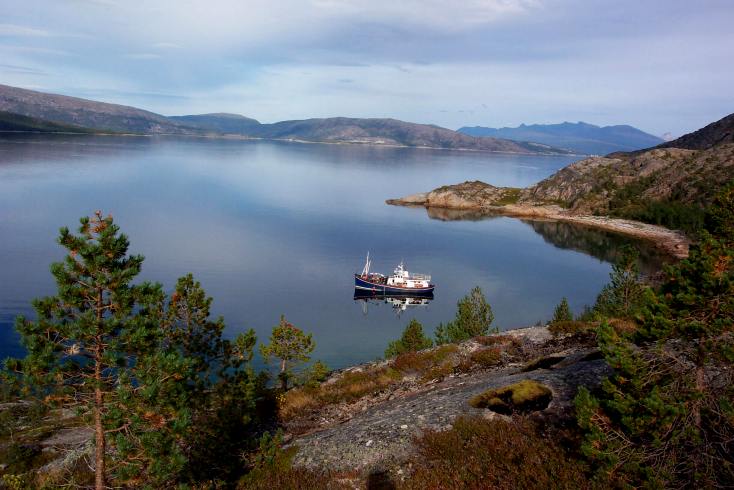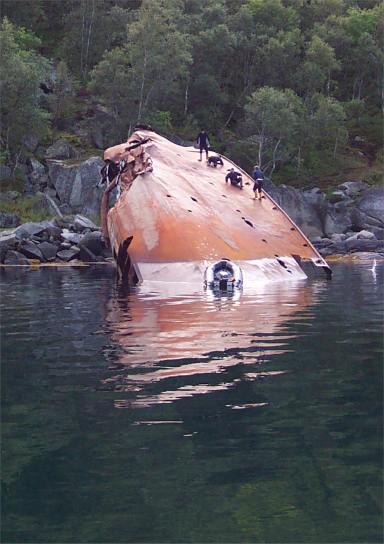
Our charter boat “Jane R” in a Norwegian fjord close to Narvik
Shipwrecks
diving into history
Diving Z2
Georg Thiele
–
the wreck of a German destroyer, in Narvik
Written by Sarah
Burbridge
(All photograph are copyrighted to S. Burbridge unless otherwise stated.)
Despite being in the Arctic Circle, the August sun was shining, the sky a glorious blue, and the water temperature a bearable 47ºF/8ºC. The wreck of the German destroyer Z2 Georg Thiele can be found not far from Narvik harbour in northern Norway.

Our charter boat “Jane
R” in a Norwegian fjord close to Narvik
Georg Thiele started life in October 1934 in the Deutsche Werke shipyard in Kiel, Germany. She was one of 4 destroyers built in this “Zerstörer 1934” class – the first destroyers Germany had manufactured since the end of World War One. Their production was rapid and based upon a poorly adapted torpedo boat design. Z2 Georg Thiele was named after a much-respected First World War officer, Georg Thiele, commander of the VIIth Flotilla of Torpedo Boats, who died in battle on 17 October 1914. This 3156 tonnes destroyer was launched on 18 August 1935, fitted out and completed by the end of February 1937, and delivered into the hands of Korvettenkapitän (KK) Hartmann.
Like all in her class, she proved awkward in heavy seas allowing waves to swamp her bows and render the forward artillery useless. Signs of structural weakness quickly appeared in her hull exasperated by violent vibrations emanating from the new-design high-pressure turbine engines. Z2 was frequently in shipyards for repair work in between patrols.
Germany invaded Poland 1 September 1939 and Georg Thiele witnessed this event first hand as part of the 1st Destroyer Division. Now under the command of KK Max-Eckart Wolff[1] she patrolled Polish waters in the Baltic near Gdansk (known then as Danzig) from the beginning of the month until 16 September. Z2 then returned to the port of Wilhelmshaven in northwest Germany with her sister ship Z1.
Norway, together with the rest of Scandinavia, had up till then remained neutral. However, its geographical location and the ample supply of good quality iron ore - essential for the much in demand steel industry - proved too tempting to both Germany and Britain.
Following yet more repair work in Bremen, Z2 was deemed fit enough to join the Kriegsschiffgruppe 1 and headed north to Narvik on 6 April 1940, as part of Operation Weserübung. Germany landed troops throughout Norway at Oslo, Kristiansand, Egersund, Bergen and Trondheim as well as Narvik where 10 German destroyers, each carrying 200 mountain troops and coastal artillery personnel, steamrollered past the ill-prepared Norwegian coastal defence vessels Norge and Eidsvold and took Narvik by storm on 9 April 1940.
Meanwhile, the British had also been preparing for their invasion of neutral Norway. However, they were not quite as quick as the Germans and the 2nd Destroyer Flotilla, headed by Captain Bernard Warburton-Lee in HMS Hardy, failed to arrive in Narvik’s Ofotfjord until the next day, 10 April. Both British and Germans fought fiercely in what has now become known as “The First Battle of Narvik”. By the end of the day the Kriegsmarine had lost 2 destroyers - Wilhelm Heidkamp and Anton Schmitt – whilst 2 more destroyers had been badly damaged: a hit on Diether von Roeder caused a fire; and Georg Thiele received 7 hits in total rendering her No.1 gun useless and damaging one of her boilers. In return Georg Thiele did manage to inflict significant damage on the British fleet – both HMS Hardy and HMS Hunter took repeated blows from her contributing to their eventual sinking[2] and HMS Hotspur also suffered severe damage from Z2’s attacks. However, the Germans also lost 8 merchant ships and their ammunition ship Rauenfels.

The exposed bow section of
Z2 Georg Thiele
Recognising the need for reinforcements the British retreated from Narvik harbour and waited until the mighty battleship HMS Warspite and the aircraft carrier HMS Furious could join them. On 13 April Warspite, together with nine Allied destroyers, launched their counterattack. The German ships, not having anticipated such a fierce combat so soon after arriving in Norway, were low on supplies - especially fuel after their long journey and, with the loss of Rauenfels, ammunition was also limited. Still recovering from the sea battle just 3 days earlier the fleet was in a poor condition to defend its newly claimed port and with no fuel to escape to sea the troops tried to flee on land. The Second Battle of Narvik saw many of the German destroyers run fast aground at the edge of fjords, allowing their crew and troops to jump ashore into the wooded hillsides before charges were set to disable the ships.
One of the first casualties of the day was the German U-boat U64 that was taken by surprise by a Swordfish from Warspite. Z2 Georg Thiele, already disabled from the First Battle of Narvik, limped into Rombaksfjord with 3 other German destroyers, firing her remaining ammunition as she went. In the course of battle she took on fresh wounds from HMS Eskimo and HMS Forester who pounded her with a barrage of shellfire. Before Z2 beached, enabling her troops from the 3rd German Mountain division to jump ashore, her Torpedo Officer, Lt. Sommer fired a torpedo and succeeded in blowing the entire bow section off Captain Micklethwait’s HMS Eskimo. The destroyer HMS Cossack also received damage during this conflict. The Kriegsmarine destroyers that didn’t make the shore were sunk by the British fleet
The mountain troops, together with the destroyer crews that had landed them, and a parachute battalion dropped in from the air, made their way through the unfamiliar cold mountainous landscape to the port and occupied Narvik. The British were sent reinforcements and following fierce land combat they finally gained control of Narvik on 28 May. However, the retreating Germans had already sabotaged the main attraction - the iron ore works - and given the situaation in France, Holland and Belgium at this time the British decided their troops were more desperately needed on other fronts and so despite this hard-won victory retreated from Norway altogether allowing the Germans to reclaim the area.

Georg
Thiele’s bell on display in Narvik’s War Museum
These
two brief and violent sea battles for Narvik saw the loss of the entire German
destroyer fleet in Narvik. Combined
together, the two sides lost more than 50 ships, submarines and airplanes, as
well as many men.
A table
listing the destroyers involved in the fight for Narvik:
German
Destroyers
|
|
|
Z21
Anton Schmitt |
Lost
10 April 1940 |
|
Z22
Wilhelm Heidkamp |
Lost
10 April 1940 |
| Z17
Diether von Roeder |
Damaged
10Apr Lost 13Apr |
|
Z2
Georg Thiele |
Damaged
10Apr Lost 13Apr |
|
Z9
Wolfgang Zenker |
Lost
13 April 1940 |
|
Z11
Bernd von Arnim |
Lost
13 April 1940 |
|
Z12
Erich Giese |
Lost
13 April 1940 |
|
Z13
Erich Koellner |
Lost
13 April 1940 |
|
Z18
Hans Ludemann |
Lost
13 April 1940 |
|
Z19
Hermann Kunne |
Lost
13 April 1940 |
|
|
|
Allied
Destroyers
|
|
|
HMS
Hardy |
Lost
10 April 1940 |
|
HMS
Hunter |
Lost
10 April 1940 |
|
HMS
Hotspur |
Damaged
13Apr1940 |
|
HMS
Icarus |
|
|
HMS
Kimberley |
|
|
HMCS
Foxhound |
|
|
HMCS
Hero |
|
|
HMS
Forester |
|
|
HMS
Cossasck |
Damaged
13Apr1940 |
|
HMS
Eskimo |
Damaged
13Apr1940 |
|
HMS
Punjabi |
|
|
HMS
Bedouin |
|
Sixty-four years on, in 2004, Z2 Georg Thiele still lies where she was abandoned and makes a spectacular dive site. Providing permission is sought this shipwreck is suitable for all levels of divers and also non-divers - 50 feet of the bow protrudes above the surface, where Commander Wolff rammed her ashore facilitating the desperate escape of all onboard. This age-rusted section, gleaming a burnt sienna in the sunlight, can easily climbed upon and explored.
The bow’s steel pinnacle thrusting upwards creates a powerful image, imitating the mountainous terrain surrounding it. Beneath the surface the diver can swim along the length of the ship gradually getting deeper until the stern is reached in approximately 50 metres. Evidence of the scuttling can be seen at the level of the engine-room which bears the scars of an explosion – a gaping hole and much torn steel. There is a lot of debris to be found both close to the damaged section and further a field, including bits of uniform which were once proudly worn by German sailors and intact documentation with pages that can still be turned and the text clearly readable.

©Ralf
Bublitz
Underwater
photograph showing a page
from one of the documents found on the wreck.
Fascinating though these artefacts may be they should remain where they are found as the Norwegian authorities are very strict concerning the unauthorised removal of such “souvenirs” and are liable to search divers at any time. The ship lies on her starboard side and apart from the engine room section remains pretty much intact. As usual in these Norwegian fjords, the visibility was close to 15 metres and the tides were gentle. There were some, but not many, fish to be found on this wreck - although there are plenty of large starfish, crabs and jelly fish around.
Georg
Thiele
specifications:
|
Length |
119
metres |
|
Beam |
11.3
metres |
|
Draft |
4.23
metres |
|
Displacement |
3156
tonnes |
|
Crew |
325
men |
|
2
Engine shafts |
|
|
2
Wagner Geared Turbines |
|
|
Speed |
38
knots |
|
Armaments
: 60 mines |
|
|
8
torpedo tubes |
|
|
5
x 127cm L/45 C/34 (5x1) |
Main
Battery |
|
4x37mm/83
C30 (2x2), 4x20mm C38 (4x1) |
Anti-air
battery |

Exploring
the bow
Diving
the Z2 Georg Thiele was made possible thanks to Graham Jinks at SeaTech
Divers who organised the expedition and Gordon Wadsworth, the extraordinary
captain of the charter ship Jane R.
[1] Wolff commanded Z2 from October 1938 – April 1940. He was awarded the Knights Cross in August 1940 and went on to command the 5th Destroyer Flotilla from Feb 1943 – Feb 1944.
[2] Commander of the Fleet Warburton-Lee was lost with his ship HMS Hardy. He was awarded (posthumously) the first Victoria Cross of World War Two.